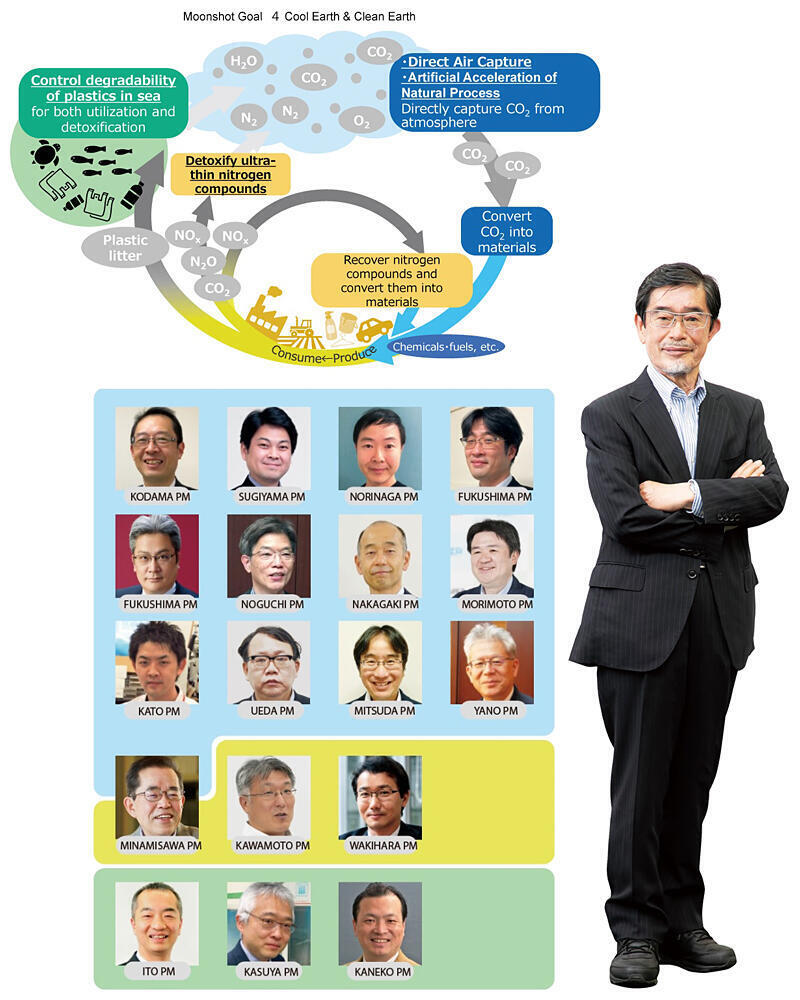Taking on the challenges of creating a comfortable future where we can easily live - Pursuing both recovery of the global environment and developing civilization
In this interview, we are introducing the Moonshot Goal 4: Realization of sustainable resource circulation to recover the global environment by 2050. The key of this program is a different approach to resource circulation than has been used in the past. How can we recover materials released into the environment and re-use them as resources? And how can we detoxify the materials when they are released into the environment, and make them harmless? The aim is to recover the global environment while continuing consumption related to human activities. Yuji Shimizu, a Science Communicator at Miraikan - the National Museum of Emerging Science and Innovation, interviewed Program Director Kenji Yamaji, President of the Research Institute of Innovative Technology for the Earth (RITE).
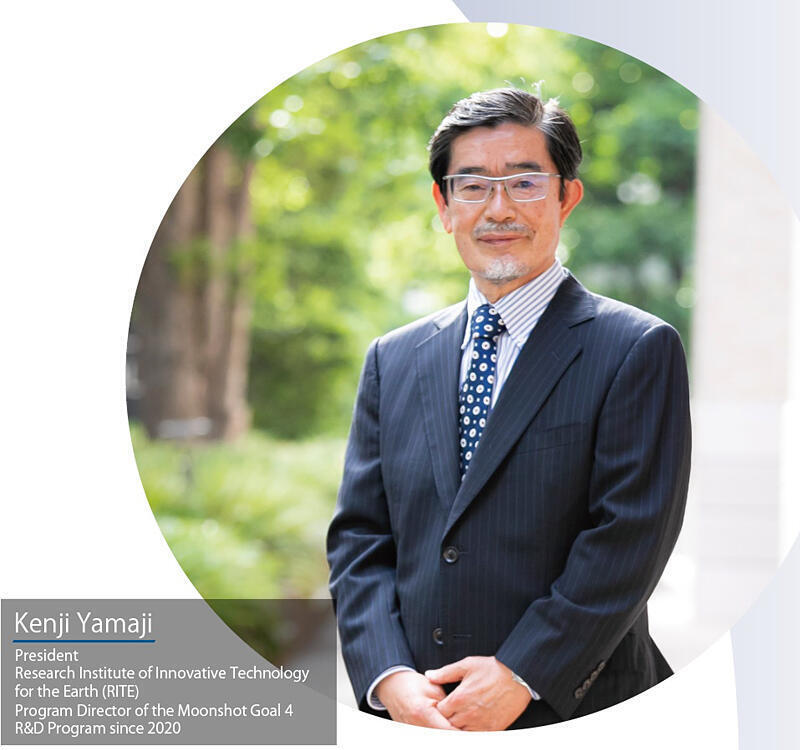
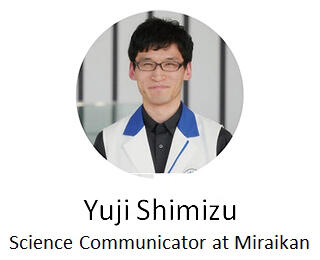
Realizing circulation of substances which are released into the environment, that is different from conventional resource recycling
Shimizu: The theme of this goal is the realization of resource circulation. How is this different to what has been done up to now?
Yamaji: When we think resource circulation, I probably think people imagine recycling, which is the process of recovering and reusing things within our society. On the other hand, the challenge this time is to ensure the circulation of substances that have been released into the environment.
Shimizu: Which areas are the targets?
Yamaji: We are focusing on three areas. The first one is greenhouse gases such as carbon dioxide (CO2), which is considered the cause of global warming. We recover these from the atmosphere using a method known as Direct Air Capture (DAC) and change them into useful substances.
The second one is marine plastic litters. We will develop technology that ensures degradation initiation switches for biodegradable plastics to make them harmless after being flowed into the sea.
The third one is nitrogen compounds. We are taking on the challenge of detoxifying nitrogen compounds discharged into the environment which are extremely diluted, recover them, and convert them into valuable materials.
Shimizu: Compared to the other two issues, nitrogen compounds are less discussed.
Yamaji: Nitrogen is a higher priority, rather than nitrogen compounds. Nitrogen is the primary component of the atmosphere, and technology has been developed to fix this nitrogen into ammonia to create fertilizer, enabling mass-production of food. On the positive side, this has the benefit of avoiding a food crisis, but on the other hand it has a significant impact on the natural nitrogen cycle. Fertilizers (nitrogen compounds) are released into the environment, causing the eutrophication of water (overgrowth of algae, etc. induced by excessive nutrients) and atmosphere pollution, leading to the emission of nitrous oxide, a greenhouse gas.
Shimizu: Is this a serious issue?
Yamaji: There's a concept called 'planetary boundaries.' This denotes the burden levels of different areas, such as climate change and biodiversity, versus the original environmental capacity of Earth. Of these, nitrogen compounds stick out the most. Since this subject isn't reaching the general public, I think it's important to address it as a theme.
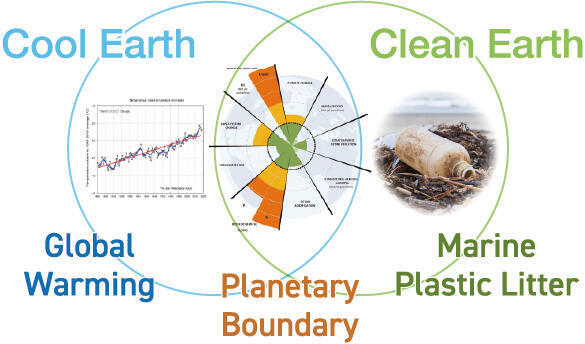
How to integrate 3 areas and 18 themes?
Shimizu: What are the specific themes?
Yamaji: There are 18 projects in MS Goal 4: 12 concerning CO2, 3 concerning marine plastic litter, and 3 concerning nitrogen. Proposals for CO2 recovery methods include physical adsorption, chemical substances absorption, and membrane separation. As an example of changing recovered CO2 into a useful substance, one project is making it adsorb on concrete. The CO2 is adsorbed on concrete to be wasted, and converted into a mineral called calcium carbonate and put to use. There are also other ways of using it, including making it into chemicals or fuel. With regard to marine plastic litter, we are trying to develop plastics that have sufficient strength when they are in use, then when they flow into the ocean, they are switched on and decompose. There are several ways, such as to use light and microorganisms as a switch for this purpose. When it comes to nitrogen, our research includes changing the recovered nitrogen compounds to ammonia and using this, and more.
Shimizu: There are so many themes!
Yamaji: As Program Director, I ensure that our researchers' different ideas integrate well and adjust their relative positions, and endeavor to control and manage all of them in the most suitable conditions. My policy is to first adopt a wide range of themes with an emphasis on taking on challenges, and then choose the good ones from among them. It is important to carefully evaluate what results have been achieved and follow up to make use the most of them.
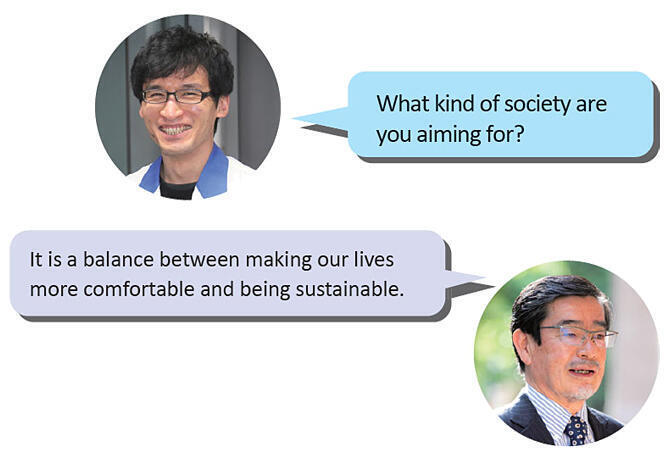
Realizing carbon neutrality while improving quality of life
Shimizu: Will our way of life change?
Yamaji: This is also connected to the policies of countries aiming to be "carbon neutral", but a virtuous cycle of the economy and the environment is vital. People expect the economy to grow and thus the everyday lives of citizens to improve by taking on the challenge of carbon neutrality. This goal is responsible for a part of this. For example, up to now, most of our fuels were fossil fuels. Fossil fuels contain carbon, and similarly atmospheric CO2 also contains carbon, consequently the possibility of creating fuel from the atmosphere in the future has been suggested. Of course, the energy we use then will not emit new CO2. If we can turn recovered nitrogen compounds into ammonia, we can use this as fuel. This will be a measure against global warming and, at the same time, enable us to continue using the facilities and equipment we have used up to now in an environmentally friendly way. Until now, most ideas about measures for the environment have involved restraining ourselves and saving energy, but this is not the case here.
Shimizu: Then this goal aims for both better lifestyles and carbon neutrality, without restraining ourselves?
Yamaji: That's right. I think the perspective of achieving this in the context of leading enjoyable lives is extremely important. When it comes to innovation, improving people's quality of life is crucial. Concrete results are necessary for research and development, but I want people to be aware of this.
Shimizu: What would you like to tell young researchers and students?
Yamaji: As this is a long project (10 years), I would like to encourage young researchers to take on the challenge and join in. I anticipate a virtuous cycle will emerge from this challenge and its outcomes.
The key players in advancing research and development are universities, but I believe that collaboration with companies is extremely important when it comes to social implementation. This project will also serve as a means for such experience, I hope you will take this opportunity to gain good experiences of taking on challenges and enjoying them.
